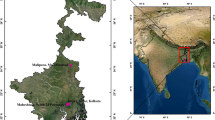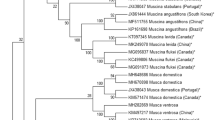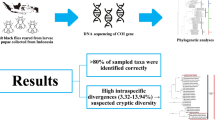Abstract
Unequivocal identification of insect specimens is an essential requirement in forensic entomology. With the development of molecular identification, spate of discussions about the feature of the DNA fragments have been raised. Relying solely on single DNA fragment for delimiting closely related species is supposed to be dangerous. Aiming at obtaining more reliable markers that might be universally used, we explore the utility of 700-bp COI fragment and 678-bp period gene fragment in the identification of Sarcophagidae (Diptera). Thirty-six sarcophagid fly specimens were collected from 19 locations in 11 Chinese provinces. Phylogenetic analysis of the sequenced segments showed that all sarcophagid specimens were properly assigned into nine species with relatively strong supporting values, which indicated the possibility of separation congeneric species with COI and period gene fragments. The difference between intraspecific threshold and interspecific divergence confirmed that the combination of nuclear and mitochondrial genes for species identification is much more accurate. The results of this research will be instrumental for implementation of the Chinese Sarcophagidae database.


Similar content being viewed by others
References
Amendt J, Krettek R, Zehner R (2004) Forensic entomology. Naturwissenschaften 91:51–65
Hu C, Wang JF (2000) Diptera with forensic importance. In: Hu C, Min JX (eds) Forensic entomology. Chongqing, Chongqing, pp 96–160
Meng FM, Cai JF (2011) Insect with forensic importance. In: Cai JF (ed) Modern and practical forensic entomology. People’s Medical, Beijing, pp 37–60
Byrd JH, Castner JL (2001) Insects of forensic importance. In: Byrd JH, Castner JL (eds) Forensic entomology: utility of arthropods in legal investigation. CRC, Boca Raton, pp 43–80
Wells JD, Pape T, Sperling FAH (2001) DNA-based identification and molecular systematics of forensically important Sarcophagidae. J Forensic Sci 46:1098–1102
Pohjoisma¨ki JLO, Karhunen PJ, Goebeler S, Saukko P, Sa¨a¨ksja¨rvi IE (2010) Indoors forensic entomology: colonization of human remains in closed environments by specific species of sarcosaprophagous flies. Forensic Sci Int 199:38–42
Mulieri PR, Mariluis JC, Aballay FH (2012) Two species of Microcerella (Diptera: Sarcophagidae) found in highland arid landscapes of Argentina, during forensic studies. J Med Entomol 49:183–191
Cherix D, Wyss C, Pape T (2012) Occurrences of flesh flies (Diptera: Sarcophagidae) on human cadavers in Switzerland, and their importance as forensic indicators. Forensic Sci Int 220:156–163
Pape T (1996) Catalogue of the Sarcophagidae of the world (Insecta: Diptera). Associated Publishers, Gainesville
Lu BL, Wu HY (2003) Classification and identification of important medical insects of China. Henan science and technology, Zhengzhou
Smith KGV (1986) A manual of forensic entomology. The Trustees of the British Museum (Natural History), London
Wells JD, Stevens JR (2008) Application of DNA-based methods in forensic entomology. Annu Rev Entomol 53:103–120
Meiklejohn KA, Wallman JF, Dowton M (2013) DNA barcoding identifies all immature life stages of a forensically important flesh fly (Diptera: Sarcophagidae). J Forensic Sci 58:184–187
Jordaens K, Sonet G, Richet R, Dupont E, Braet Y, Desmyter S (2013) Identification of forensically important Sarcophaga species (Diptera: Sarcophagidae) using the mitochondrial COI gene. Int J Legal Med 127:491–504
Meiklejohn KA, Wallman JF, Dowton M (2011) DNA-based identification of forensically important Australian Sarcophagidae (Diptera). Int J Leg Med 125:27–32
Tan SH, Rizman-Idid M, Mohd-Aris E, Kurahashi H, Mohamed Z (2010) DNA-based characterisation and classification of forensically important flesh flies (Diptera: Sarcophagidae) in Malaysia. Forensic Sci Int 199:43–49
Harvey ML, Dadour IR, Gaudieri S (2003) Mitochondrial cytochrome oxidase I gene: potential for distinction between immature stages of some forensically important fly species (Diptera) in western Australia. Forensic Sci Int 131:134–139
Zehner R, Amendt J, Schütt S, Sauer J, Krettek R, Povolný S (2004) Genetic identification of forensically important flesh flies (Diptera: Sarcophagidae). Int J Legal Med 118:245–247
Ames C, Turner B, Daniel B (2006) The use of mitochondrial cytochrome oxidase I gene (COI) to differentiate two UK blowfly species—Calliphora vicina and Calliphora Vomitoria. Forensic Sci Int 164:179–182
Desmyter S, Gosselin M (2009) COI sequence variability between Chrysomyinae of forensic interest. Forensic Sci Int Genet 3:89–95
Guo YD, Cai JF, Meng FM, Chang YF, Gu Y, Lan LM, Liang L, Wen JF (2012) Identification of forensically important flesh flies based on a shorter fragment of the cytochrome oxidase subunit I gene in China. Med Vet Entomol 26:307–313
Stevens JR, Wall R, Wells JD (2007) Paraphyly in Hawaiian hybrid blowfly populations and the evolutionary history of anthropophilic species. Insect Mol Biol 11:141–148
Wells JD, Wall R, Stevens JR (2007) Phylogenetic analysis of forensically important Lucilia flies based on cytochrome oxidase I: a cautionary tale for forensic species determination. Int J Leg Med 121:229–233
Zaidi F, Wei SJ, Shi M, Chen XX (2011) Utility of multi-gene loci for forensic species diagnosis of blowflies. J Insect Sci 11:59
Nelson LA, Wallman JF, Dowton M (2007) Using COI barcodes to identify forensically and medically important blowflies. Med Vet Entomol 21:44–52
Nelson LA, Wallman JF, Dowton M (2008) Identification of forensically important Chrysomya (Diptera: Calliphoridae) species using the second ribosomal internal transcribed spacer (ITS2). Forensic Sci Int 177:238–247
Guo YD, Cai JF, Chang YF, Li X, Liu QL, Wang XH et al (2011) Identification of forensically important sarcophagid flies (Diptera: Sarcophagidae) in China, based on COI and 16S rDNA gene sequences. J Forensic Sci 56:1534–1540
Konopka RJ, Benzer S (1971) Clock mutants of Drosophila melanogaster. Proc Natl Acad Sci U S A 68:2112–2116
Bradshaw W, Holzapfel C (2007) Tantalizing timeless. Science 316:1851–1852
Giebultowicz JM (2000) Molecular mechanism and cellular distribution of insect circadian clock. Annu Rev Entomol 45:769–793
Kosˇta’l V, Za’vodska’ R, Denlinger D (2009) Clock genes period and timeless are rhythmically expressed in brains of newly hatched, photosensitive larvae of the fly, Sarcophaga crassipalpis. J Insect Physiol 55:408–414
Roe AD, Sperling FAH (2007) Patterns of evolution of mitochondrial cytochrome c oxidase I and II DNA and implications for DNA barcoding. Mol Phylogenet Evol 44:325–345
Tourle R, Downie DA, Villet MH (2009) A morphological and molecular comparison of Lucilia cuprina and L. sericata (Diptera: Calliphoridae) in South Africa. Med Vet Entomol 23:6–14
Amendt J, Campobasso CP, Gaudry E, Reiter C, LeBlanc HN, Hall MJR (2007) Best practice in forensic entomology—standards and guidelines. Int J Legal Med 121:90–104
Baqué M, Amendt J (2013) Strengthen forensic entomology in court—the need for data exploration and the validation of a generalised additive mixed model. Int J Legal Med 127:213–223
Xu WQ, Zhao JM (1996) Flies of China. Liaoning Science and Technology, Shenyang
Guo YD, Cai JF, Su RN, Chang YF, Lan LM, Wen JF (2010) Comparison of mtDNA extraction from different parts of sarcosaphagous insects. Fa Yi Xue Za Zhi 26:336–339
Han B, Denlinger DL (2009) Length variation in a specific region of the period gene correlates with differences in pupal diapause incidence in the flesh fly, Sarcophaga bullata. J Insect Physiol 55:415–418
Tamura K, Dudley J, Nei M, Kumar S (2011) MEGA5: Molecular Evolutionary Genetics Analysis using Maximum Likelihood, Evolutionary Distance, and Maximum Parsimony Methods. Mol Biol Evol 28:2731–2739
Saitou N, Nei M (1987) The neighbor-joining method: a new method for reconstructing phylogenetic trees. Mol Biol Evol 4:406–425
Felsenstein J (1985) Confidence limits on phylogenies: an approach using the bootstrap. Evolution 39:783–791
Tamura K, Nei M, Kumar S (2004) Prospects for inferring very large phylogenies by using the neighbor-joining method. Proc Natl Acad Sci U S A 101:11030–11035
Vanin S, Gherardi M, Bugelli V, Di Paolo M (2011) Insects found on a human cadaver in central Italy including the blowfly Calliphora loewi, (Diptera, Calliphoridae), a new species of forensic interest. Forensic Sci Int 207:E30–E33
Acknowledgments
This study was supported by the National Natural Science Foundation of China (NSFC, no. 81302615), Science Foundation for The Youth Scholars of Central South University (no.120959), and Central South University student innovation test plan (2282013bks070). Yadong Guo is a postdoctoral fellow of School of Basic Medical Sciences. Thanks to all the members of the forensic interest community of Central South University for samples collection. We also thank Prof. SONG Dong-Bao and Ph.D. HUANG Guo-Hua (Plant Protection Department, College of Bio-safety Science and Technology, Hunan Agricultural University) for identifications of insects.
Conflict of interest
None
Author information
Authors and Affiliations
Corresponding author
Electronic supplementary material
Below is the link to the electronic supplementary material.
ESM 1
(DOC 118 kb)
Rights and permissions
About this article
Cite this article
Guo, Y., Zha, L., Yan, W. et al. Identification of forensically important sarcophagid flies (Diptera: Sarcophagidae) in China based on COI and period gene. Int J Legal Med 128, 221–228 (2014). https://doi.org/10.1007/s00414-013-0923-7
Received:
Accepted:
Published:
Issue Date:
DOI: https://doi.org/10.1007/s00414-013-0923-7




